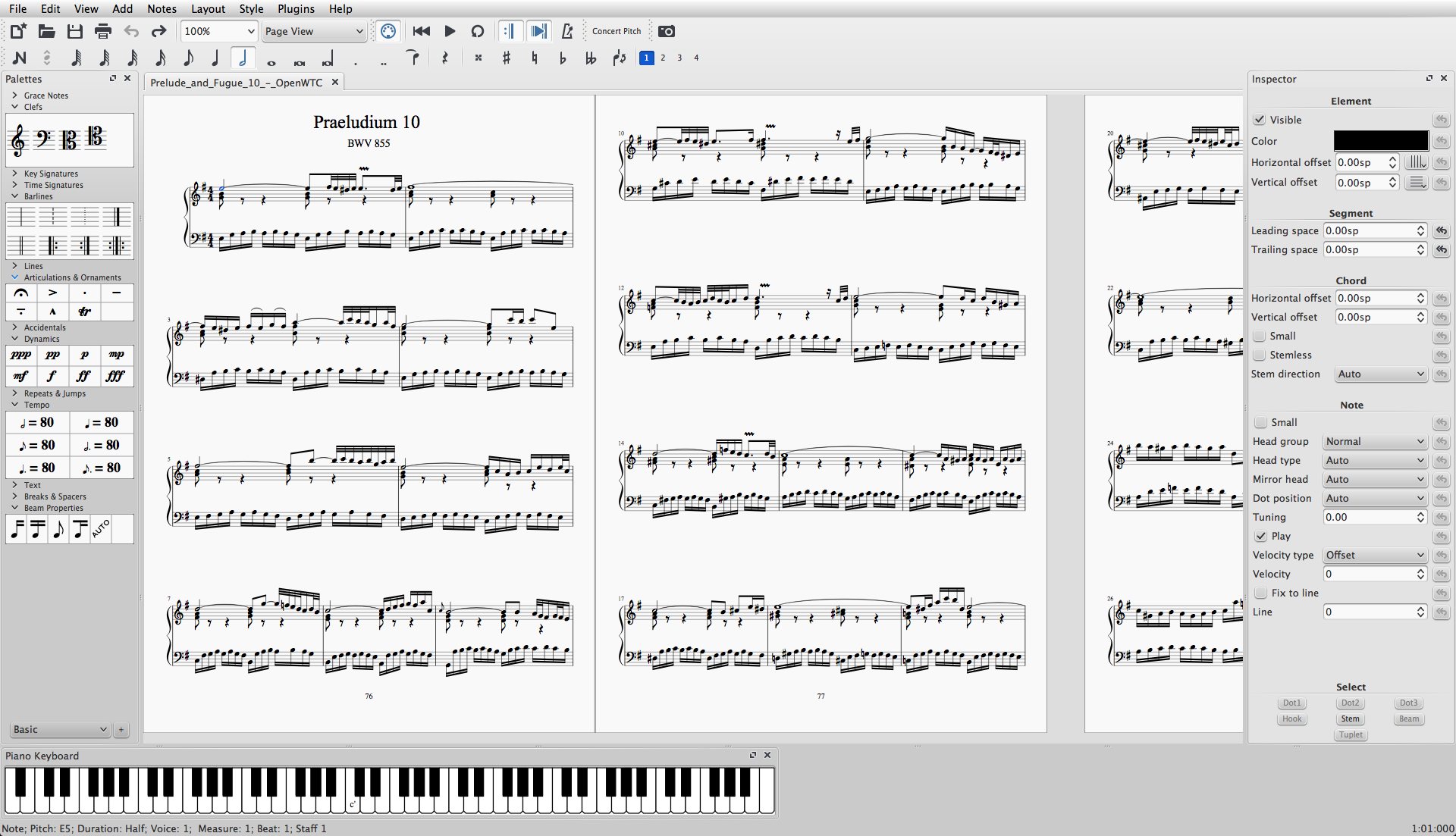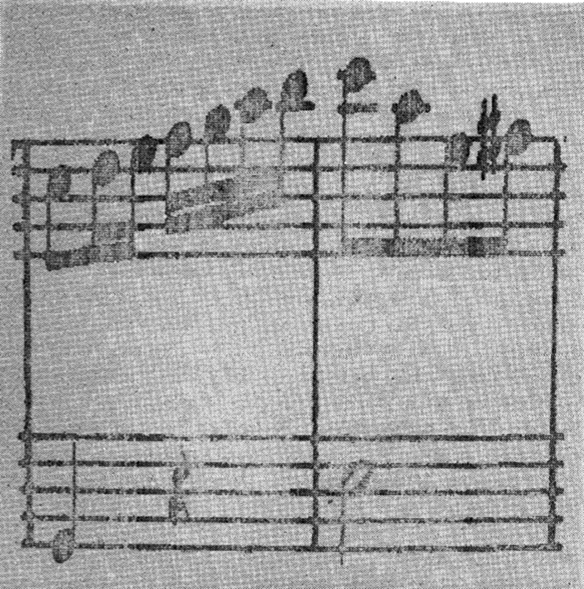|
Notation Interchange File Format
Notation Interchange File Format (NIFF) is a music notation file format used primarily for transferring music notation between different scorewriters. The NIFF project was started in February 1994 to create an open format that would allow exchange of music between various scanning / Optical music recognition, editing and typesetting programs. The project was sponsored by several music notation software publishers. The NIFF format itself is based upon RIFF (Resource Interchange File Format), a file structure provided by Microsoft, in which data is divided into Lists, Chunks and Tags. Almost all data in a NIFF file are optional. The level of detail contained can range from just the pitch and timing (akin to MIDI) to a precise page layout, embedded graphics and embedded MIDI information. Though detailed and comprehensive, the standard never really caught on except for limited interchange between Optical music recognition software and score writing software. Three of the Optical music ... [...More Info...] [...Related Items...] OR: [Wikipedia] [Google] [Baidu] |
Music Notation
Music is generally defined as the art of arranging sound to create some combination of form, harmony, melody, rhythm or otherwise expressive content. Exact definitions of music vary considerably around the world, though it is an aspect of all human societies, a cultural universal. While scholars agree that music is defined by a few specific elements, there is no consensus on their precise definitions. The creation of music is commonly divided into musical composition, musical improvisation, and musical performance, though the topic itself extends into academic disciplines, criticism, philosophy, and psychology. Music may be performed or improvised using a vast range of instruments, including the human voice. In some musical contexts, a performance or composition may be to some extent improvised. For instance, in Hindustani classical music, the performer plays spontaneously while following a partially defined structure and using characteristic motifs. In modal jazz ... [...More Info...] [...Related Items...] OR: [Wikipedia] [Google] [Baidu] |
Scorewriter
A scorewriter, or music notation program is software for creating, editing and printing sheet music. A scorewriter is to music notation what a word processor is to text, in that they typically provide flexible editing and automatic layout, and produce high-quality printed results. Most scorewriters, especially those from the 2000s, can record notes played on a MIDI keyboard (or other MIDI instruments), and play music back via MIDI or virtual instruments. Playback is especially useful for novice composers and music students, and when musicians are not available or affordable. Several free programs are widely used, such as MuseScore. The three main professional-level programs are Finale, Sibelius and Dorico. Comparison with multitrack sequencer software Multitrack sequencer software and scorewriters typically employ different methods for notation input and display. Scorewriters are based on traditional music notation, using staff lines and round note heads, which originates f ... [...More Info...] [...Related Items...] OR: [Wikipedia] [Google] [Baidu] |
Optical Music Recognition
Optical music recognition (OMR) is a field of research that investigates how to computationally read musical notation in documents. The goal of OMR is to teach the computer to read and interpret sheet music and produce a machine-readable version of the written music score. Once captured digitally, the music can be saved in commonly used file formats, e.g. MIDI (for playback) and MusicXML (for page layout). In the past it has, misleadingly, also been called "music optical character recognition". Due to significant differences, this term should no longer be used. History Optical music recognition of printed sheet music started in the late 1960s at the Massachusetts Institute of Technology when the first image scanners became affordable for research institutes. Due to the limited memory of early computers, the first attempts were limited to only a few measures of music. In 1984, a Japanese research group from Waseda University developed a specialized robot, called WABOT (WAseda roBOT ... [...More Info...] [...Related Items...] OR: [Wikipedia] [Google] [Baidu] |
RIFF (File Format)
The Resource Interchange File Format (RIFF) is a generic file container format for storing data in tagged chunks. It is primarily used to store multimedia such as sound and video, though it may also be used to store any arbitrary data. The Microsoft implementation is mostly known through container formats like AVI, ANI and WAV, which use RIFF as their basis. History RIFF was introduced in 1991 by Microsoft and IBM, and was presented by Microsoft as the default format for Windows 3.1 multimedia files. It is based on Electronic Arts' Interchange File Format, introduced in 1985 on the Commodore Amiga, the only difference being that multi-byte integers are in little-endian format, native to the 80x86 processor series used in IBM PCs, rather than the big-endian format native to the 68k processor series used in Amiga and Apple Macintosh computers, where IFF files were heavily used. A RIFX format, which is big-endian, was also introduced. In 2010 Google introduced the WebP pic ... [...More Info...] [...Related Items...] OR: [Wikipedia] [Google] [Baidu] |
Microsoft
Microsoft Corporation is an American multinational technology corporation producing computer software, consumer electronics, personal computers, and related services headquartered at the Microsoft Redmond campus located in Redmond, Washington, United States. Its best-known software products are the Windows line of operating systems, the Microsoft Office suite, and the Internet Explorer and Edge web browsers. Its flagship hardware products are the Xbox video game consoles and the Microsoft Surface lineup of touchscreen personal computers. Microsoft ranked No. 21 in the 2020 Fortune 500 rankings of the largest United States corporations by total revenue; it was the world's largest software maker by revenue as of 2019. It is one of the Big Five American information technology companies, alongside Alphabet, Amazon, Apple, and Meta. Microsoft was founded by Bill Gates and Paul Allen on April 4, 1975, to develop and sell BASIC interpreters for the Altair 8800. It rose to do ... [...More Info...] [...Related Items...] OR: [Wikipedia] [Google] [Baidu] |
MIDI
MIDI (; Musical Instrument Digital Interface) is a technical standard that describes a communications protocol, digital interface, and electrical connectors that connect a wide variety of electronic musical instruments, computers, and related audio devices for playing, editing, and recording music. The specification originates in the paper ''Universal Synthesizer Interface'' published by Dave Smith and Chet Wood of Sequential Circuits at the 1981 Audio Engineering Society conference in New York City. A single MIDI cable can carry up to sixteen channels of MIDI data, each of which can be routed to a separate device. Each interaction with a key, button, knob or slider is converted into a MIDI event, which specifies musical instructions, such as a note's pitch, timing and loudness. One common MIDI application is to play a MIDI keyboard or other controller and use it to trigger a digital sound module (which contains synthesized musical sounds) to generate sounds, which t ... [...More Info...] [...Related Items...] OR: [Wikipedia] [Google] [Baidu] |
SmartScore
SmartScore 64 is a music OCR and scorewriter program, developed, published and distributed by Musitek Corporation based in Ojai, California. History SmartScore was originally released in 1991 as MIDISCAN for Windows. The product line was later changed to "SmartScore" and re-released for Windows 98 in 1998, and for the Macintosh Power PC in 1999 as a scanning/scoring hybrid product. Software SmartScore is a software product which performs optical character recognition on scanned music and converts it into a digital musical score that can be played back as a MIDI file, or exported as MusicXML to music engraving programs such as Sibelius and Finale. Reception Maximum PC reviewed SmartScore in 2000 and said that it "gets the job done easily", but was difficult to navigate and had a crowded layout. Also, some scores scanned by Maximum PC weren't recognized by the software.Daevid Vincent (January 2000)Makin' Madness: Put on your boogie shoes ''Maximum PC'' 5 (1): 94. ISSN 1522-4279. ... [...More Info...] [...Related Items...] OR: [Wikipedia] [Google] [Baidu] |
MusicXML
MusicXML is an XML-based file format for representing Western musical notation. The format iopen fully documented, and can be freely used under the W3C Community Final Specification Agreement. History MusicXML was invented by Michael Good and initially developed by Recordare LLC. It derived several key concepts from existing academic formats (such as Walter Hewlett's ASCII-based MuseData and David Huron's Humdrum). It is designed for the interchange of scores, particularly between different scorewriters. MusicXML development was managed by MakeMusic following the company's acquisition of Recordare in 2011. MusicXML development was transferred to the W3C Music Notation Community Group in July 2015. Version 1.0 was released in January 2004. Version 1.1 was released in May 2005 with improved formatting support. Version 2.0 was released in June 2007 and included a standard compressed format. All of these versions were defined by a series of document type definitions (DTDs). An XML Sc ... [...More Info...] [...Related Items...] OR: [Wikipedia] [Google] [Baidu] |



